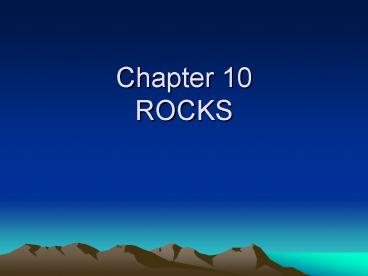Chapter 10 ROCKS - PowerPoint PPT Presentation
1 / 10
Title:
Chapter 10 ROCKS
Description:
Chapter 10 ROCKS Ch. 10.1 Rocks and the Rock Cycle Magma is the parent material for all rocks. There are three types of rocks, classified by how they are formed. – PowerPoint PPT presentation
Number of Views:139
Avg rating:3.0/5.0
Title: Chapter 10 ROCKS
1
Chapter 10ROCKS
2
Ch. 10.1 Rocks and the Rock Cycle
- Magma is the parent material for all rocks.
- There are three types of rocks, classified by how
they are formed.
3
Igneous Rocks
- Formed when magma or lava cools and hardens.
- Igneous is from the Latin term from fire.
4
Sedimentary Rock
- Formed when small fragments of rock or organic
material harden after being compressed and
cemented together.
5
Metamorphic Rock
- Forms when heat and or pressure, or chemical
processes change the form of existing rock.
6
The Rock Cycle
- Any type of rock can be changed into any other
kind of rock and back again. - Processes are
- Melting and coolingigneous.
- Compaction and cementationsedimentary.
- Heat and pressuremetamorphic.
7
Characteristics of Igneous Rocks
- Large or small crystals depending on cooling
rate. The slower the cooling rate, the larger
the crystals. - Color depends on lava or magma typefelsic
produces lighter rocks mafic produces darker
rocks. - May have trapped gas bubbles (pumice and scoria).
8
- Generally composed of silicate minerals.
9
Characteristics of Sedimentary Rocks
- Form from cemented together rock fragments,
organic material, or from minerals that
precipitate out of water. - May have layered structure from deposition of
various kinds of sediment deposited in silt beds. - Moving wind or water may cause ripple marks.
- May contain fossilsremains or traces of ancient
plants or animals.
10
Characteristics of Metamorphic Rock
- Local volcanism may cause contact metamorphism.
- Tectonic activity may cause widespread regional
metamorphism. Usually deep within the earth. - May have enlarged or alternating bands of
crystals (foliated). - May change soft sedimentary rock into hard,
durable rock.































